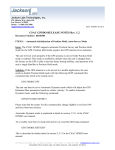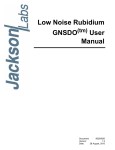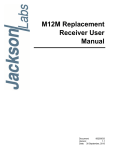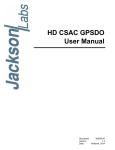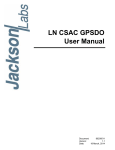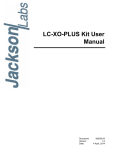Download Low Noise Rubidium GNSDO RELEASE NOTES Rev. 1.0
Transcript
Jackson Labs Technologies, Inc. 1635 Village Ctr. Cir., Suite 150 Las Vegas NV 89134 Phone: +1 (702) 233-1334 [email protected] DATE: AUGUST 18, 2015 Low Noise Rubidium GNSDO RELEASE NOTES Rev. 1.0 Document Number: 80200527 ITEM 1: - Automatic Initialization of Position Hold, Auto-Survey Mode N.B.: The LN Rb GNSDO supports automatic Position Survey and Position Hold mode for the GNSS receiver. Position Hold mode requires the GPS/Glonass antenna to be stationary. The unit will not work properly if the GNSS antenna is moved while Position Hold mode is enabled. This stationary mode is enabled by default when the unit is shipped from the factory as the GNSS is able to provide better timing stability, and operation with only a single Satellite in Position Hold mode. Solution: If the GNSS antenna is to be moved in a mobile application, the user needs to disable Position Hold mode with the following SCPI command (this command only needs to be issued once, it is stored in EEPROM): GPS:TMODE OFF The unit can then be set to Automatic Dynamic mode which will adjust the GPS Kalman filter parameters based on vehicle velocity. To enable Automatic Dynamic mode, send the following command: GPS:DYNAMIC:MODE 8 Automatic Dynamic mode is explained in detail in section 3.3.14 in the LN Rb GNSDO user manual. To re-enable Auto Survey mode after power-on, send the following command: GPS:TMODE RSTSURV This is described in further detail in section 3.3.19 in the LN Rb GNSDO user manual. 1635 Village Ctr. Cir. Dr., Suite 150 · Las Vegas, NV 89135 · USA · Phone: +1 (702) 233-1334 · [email protected] Copyright© 2012/2015 Jackson Labs. All rights reserved. Last updated: 08/18/15 ITEM 2: - Driving 50 Ohms coax cables with the 1PPS and 5MHz CMOS outputs N.B.: The 5V CMOS 1PPS and 5MHz outputs of the LN Rb GNSDO are designed to drive open-ended 50 Ohms coax cables. The drivers can supply up to 15mA of output current. These outputs should not be terminated by 50 Ohms terminations, as this would cause short-circuiting inside the output driver. Driving 5V into 50 Ohms requires a minimum current of 0.1A, which these drivers are not capable, nor designed to drive. Solution: To reduce power consumption to a minimum, CMOS outputs such as the 1PPS and 5MHz outputs on the LN Rb GNSDO are designed to drive 50 Ohm open-ended coax or PCB transmission lines without resistive end-termination. CMOS outputs are not designed to drive 50 Ohm resistive terminated inputs, and connecting a 50 Ohms resistive termination will cause a DC short circuit current to flow in the output driver chip. CMOS outputs are designed to drive 50 Ohm transmission lines and coax cables with 1K Ohms or higher end terminations. Signals will travel down the coax cable, be reflected by the open ended cable, and then return to the CSAC GPSDO where they are properly terminated by a 50 Ohms series termination, and thus the receiver connected to the coax cable will see a very well-shaped rising or falling edge without excessive ringing or over/undershoot. The principle of seriesterminating coax cables, transmission lines, or micro-strip lines driven by CMOS outputs is explained in detail in the literature; see for example the PCI bus system specification. 1635 Village Ctr. Cir. Dr., Suite 150 · Las Vegas, NV 89135 · USA · Phone: +1 (702) 233-1334 · [email protected] Copyright© 2012/2015 Jackson Labs. All rights reserved. Last updated: 08/18/15


